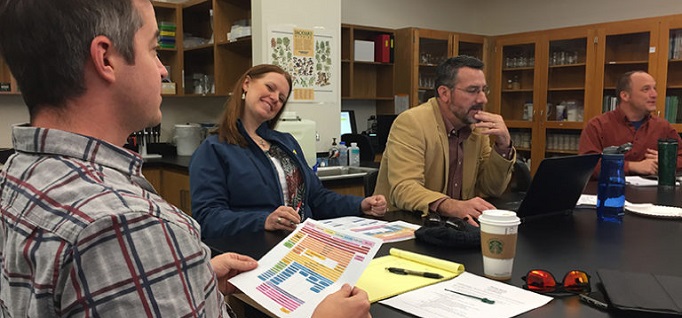Scaling up pathways at rural colleges
By Ellie Ashford
March 11, 2020
While community colleges nationwide are implementing guided pathways along with other comprehensive reforms, that process can be a little different at rural colleges.
In implementing whole-college redesign through guided pathways, rural colleges face some unique challenges but also have some advantages.
“Rural college are more nimble,” says Gretchen Schmidt, executive director of AACC’s Pathways Project. “They can implement change more quickly with more depth than large urban or suburban colleges that have to bring many more people to the table.”
If a college wants to change its advising process to a case-management approach, for example, Schmidt says, an urban college would likely have to hire more staff, while a rural college with more limited resources would be better able to use existing staff in more creative ways.
“Rural colleges also are more likely than other institutions to stop doing things they know are not working,” she adds.
Serving all students
Wallace State Community College in Alabama illustrates how a rural college can successfully implement whole-college reforms.
Wallace State, a member of the initial round of colleges in the AACC Pathways Project, has established pathways for full, part-time and dual-enrollment students and for every major and every possible scenario, says President Vicki Karolewics, a member of the AACC board of directors.
The college is currently implementing pathways for workforce and noncredit programs.
“We will have one door at Wallace State, rather than multiple doors for adult education, workforce and academic programs,” Karolewics says.
Paths to success
In 2012, Wallace State’s graduation rate was at 21 percent; it’s now up to 45 percent, and Karolewics anticipates it will continue to rise.
Data from AACC’s Voluntary Framework of Accountability shows last year’s combined graduation, transfer and persistence rate was 91 percent. In fall 2019, Wallace State had more full-time than part-time students, which Karolewics attributes to the adoption of pathways, along with an accelerated model for developmental education.
Before adopting a co-requisite approach for students who aren’t college-ready, the college had about 20 different developmental courses in English; now there are just two. Students struggling in college-level courses are given just-in-time support.
That’s really important, Karolewics says, because students who linger in developmental education for a year are less likely to persist in college. The co-requisite model is based on the idea that “every student can succeed given the right conditions for learning,” she says.
Wallace State also significantly gains reduced the achievement gap between students who are eligible for Pell grants and those from households with higher incomes.
“Last year, we closed that gap, so the percentage of students who completed college-level math, college-level English or both in their first year was the same for Pell-eligible and non-Pell eligible students,” Karolewics says.
She credits the co-requisite developmental education model as a key factor in closing the gap. Other factors include a first-semester college success course and assigning a student success coach, as well as an advisor, to every student.
Implementing innovation
In Wyoming, Laramie County Community College (LCCC) began developing a pathways 2.0 approach three years ago and plans to scale it up next fall, says President Joe Schaffer, a member of the AACC board.
That work was structured around nine “must-haves,” Schaffer says, including a streamlined entry process, a holistic advising model, the elimination of stand-alone developmental education and program mapping.
A key element was “essential student experiences,” Schaffer says, which includes collaboration, relationship building and immersion experiences – such as study abroad or experiences in an unfamiliar environment. Another important component is synthesis and applications, in which “students take everything they learned and apply it to a real-world problem by carrying out undergraduate research or a capstone project,” he says.
LCCC formed an “excellence in instruction” group, which completely redesigned the general education program based on a pathways model, Schaffer says. As a result, all general education students are exposed to certain cross-cutting practices, such as exploration, problem-solving, creativity, innovation, empathy and collaboration.
The college scaled back the number of general education courses and incorporated entrepreneurship across the general education curriculum with an eye toward meeting the needs of Wyoming’s economy, which is concentrated in the energy sector.
“Through guided pathways, we truly touched every aspect of the student experience,” Schaffer says. “It’s been like building an airplane while you’re flying it.”
While these changes won’t be fully rolled out until this fall, “we’ve already seen some nice upticks in persistence,” he says. Eight years ago, the graduation rate was just 13 percent; this year it’s up to 28 percent.
“After we scale up pathways, we have high hopes and strong beliefs it will jump up again,” Schaffer says.
There’s more to the story! Read the full article in CC Daily.


